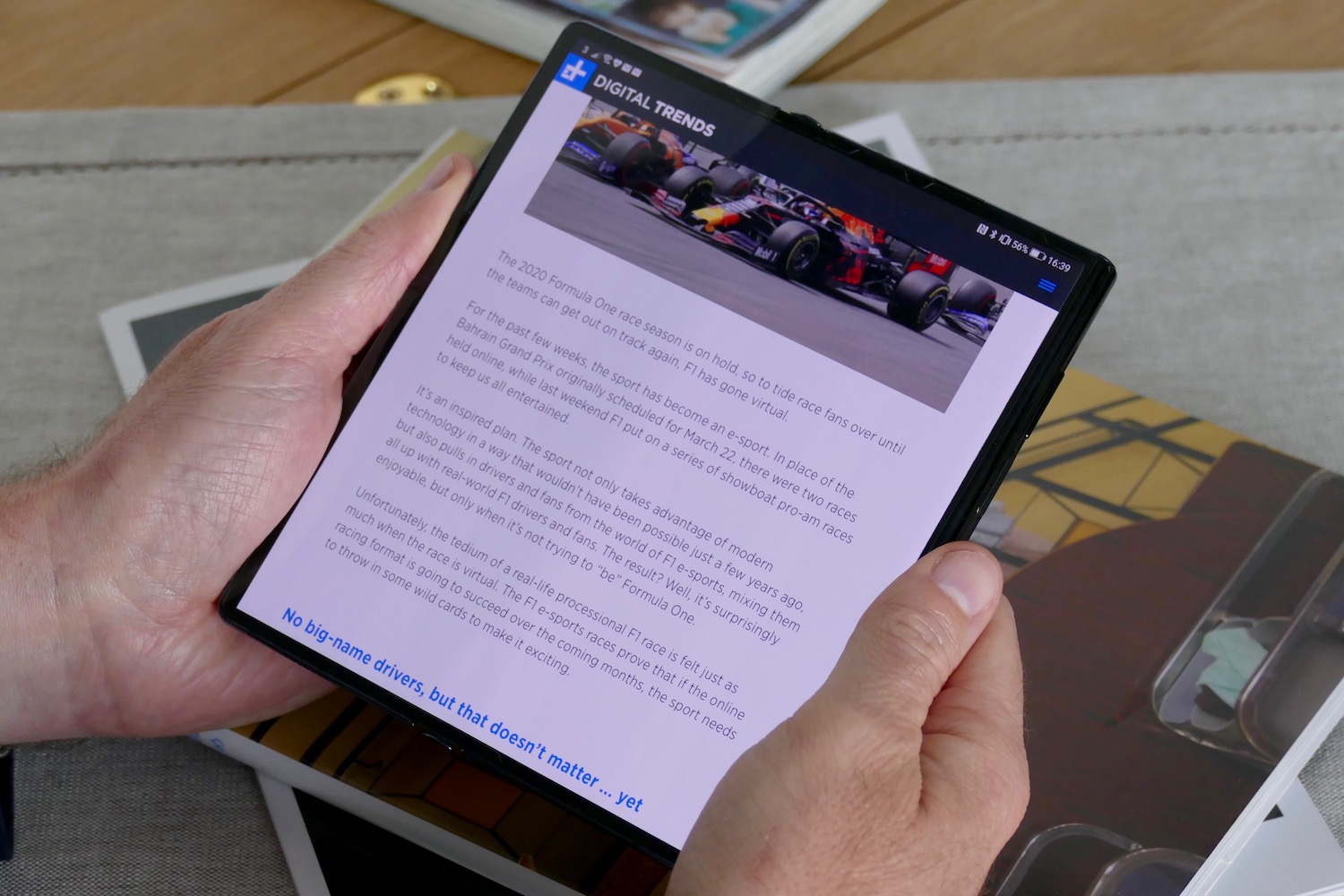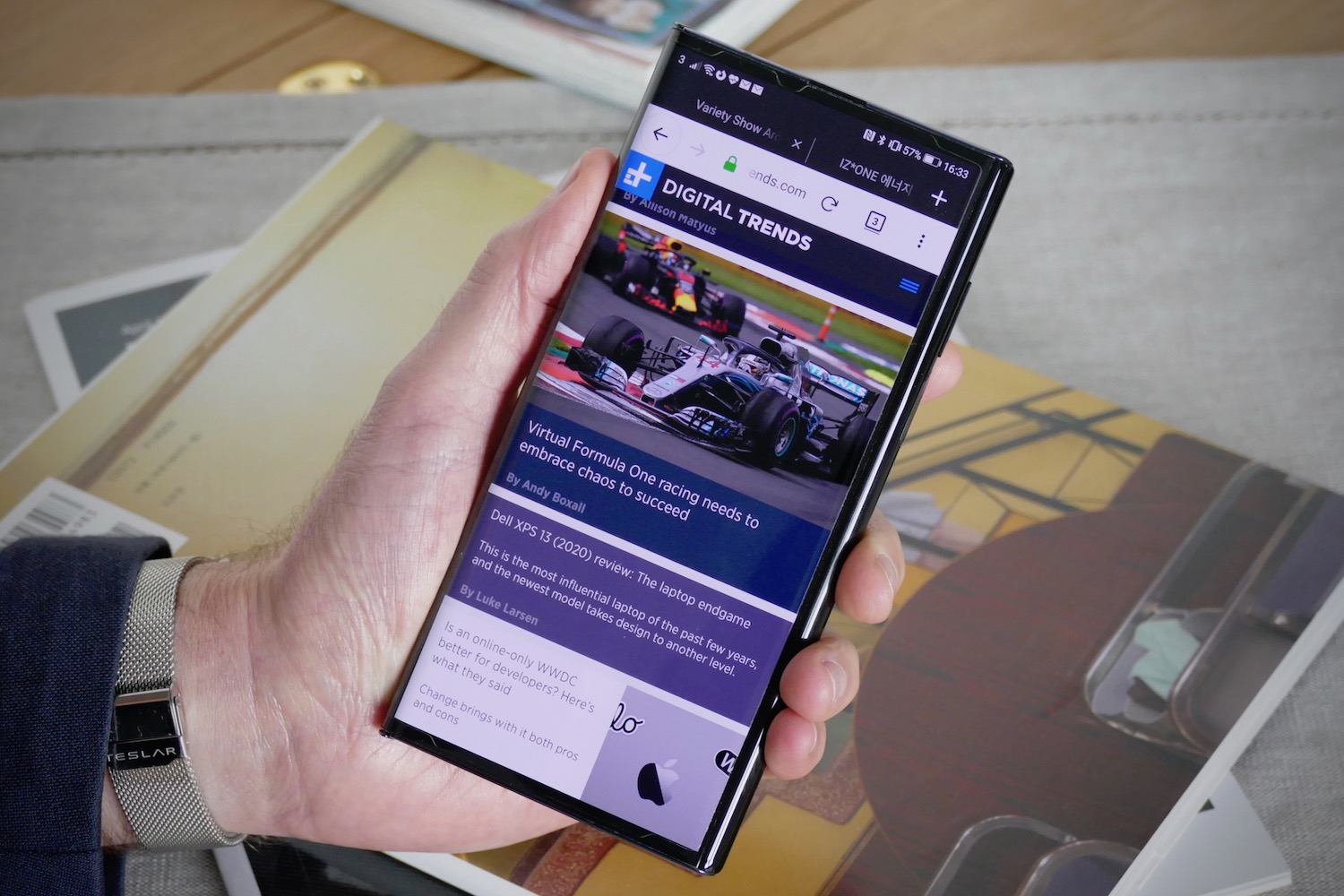“The Huawei Mate Xs is an engineering masterclass hurt by flawed software and a disappointing speaker.”
- Superbly engineered
- Usable both folded and unfolded
- Beautiful screen
- Fast charging
- Useful multi-tasking features
- Excellent camera
- Unreliable software
- No Google Mobile Services
- Poor audio
- Very expensive
- Durability is an unknown
Smartphones are usually straightforward to review. The shape and general functionality rarely changes drastically, for example. However, there is nothing straightforward about the Huawei Mate Xs. Not only is it completely different from most other phones out there because it folds, but also because it costs 2,300 British pounds, or about $2,750 U.S, and doesn’t have Google mobile services on board.
Yet it remains a compelling phone, and it’s impossible to ignore the dramatic upsides that come with ownership. They range from the viewing experience, to the camera, and even the cache of using such a futuristic phone right now. There are frustrating elements, but I’ve never wanted to stop using the Mate Xs because of them.
Design

The Huawei Mate Xs is what many people would consider a true folding smartphone, in that it looks and operates like a normal smartphone, before unfolding to become a tablet. This makes it usable all the time, with one hand or two, whether you want to quickly send a message without opening up the phone, or watch a video on the big screen. To achieve this, the Mate Xs’s big screen folds back on itself, becoming “normal size” until it’s needed again.
I found I didn’t need to unfold the screen under normal circumstances, and typing is easier when the phone is closed, because it’s exactly like using any other big, modern smartphone. This versatility — phone one minute, tablet the next — is addictive, and going back to a non-folding phone feels restrictive. It’s also less conspicuous when using the phone out in public, unlike the Galaxy Fold, which must be unfolded to be of real use. That’s handy if you don’t want to attract attention to the fact you’re using a $2,750 smartphone.

A rail on the right-hand side of the phone has a button to release the screen from its folded position. It’s easy to locate with your forefinger without looking, but you need two hands to unfold the Mate Xs. The central hinge has a wonderful, firm, high-quality action, with just the right level of resistance. It clicks into place without fuss, and stays completely flat once it’s done.
That’s a big deal because, if it was just a few degrees from being flat, the screen would look badly constructed. However, whether you view the Mate Xs’s screen folded or unfolded, it always looks exactly right. There is a crease, but it’s barely noticeable when you look straight at the phone.
Folded up, the lines are crisp, in that the back of the screen folds flat against the rail, creating a thick chunk of smartphone for you to hold. It’s 11mm thick closed and just 5.4mm thick at its thinnest point unfolded. However, at 300 grams (10.5 ounces), this is one of the heaviest smartphones available today.
Closed, it’s slippery due to the rounded sides and lack of overall grip. You can use it one-handed closed, but must grip the phone tightly. I mostly used it like the Galaxy Note 10 Plus and other big phones, holding it in one hand and swiping with the other. When open, the vertical rail running down the right-hand side becomes an excellent holding point, and an inspired piece of design.

How about durability? The construction and materials used in the screen have been upgraded over the Mate X, but there is still concern the exposed screen will quickly be ruined. I’ve been using the Mate Xs for a few weeks, in conjunction with other devices. The screen has collected a few small scratches where it curves around the side, though I can’t readily notice them when the screen is on.
Whether it gathers more scratches will only become obvious over time, as will how the hinge holds up. It has loosened a little during the last few weeks, but remains firm.
Screen
Using the Mate Xs with the screen closed is like using any other Huawei smartphone. The 6.6-inch OLED has a 2480 x 1148 pixel resolution and shows strong, dynamic colors with excellent clarity, right down to the app icons on your home screen.
Compare it to the iPhone 11 Pro’s stunning screen and the Mate Xs really challenges its superiority, producing the same natural tones that make the Apple phone’s screen a winner, then adding a pleasing level of saturation to gives it a visual boost. It’s lovely.

The fully unfurled 8-inch, 2480 x 2200-pixel screen differs from the Galaxy Fold in a few ways. Both are staggeringly sharp when playing 1440p video, with the Mate Xs again showing slightly more vibrance than its competitor, but missing out on some of the richer, more natural tones. The unfolded Mate Xs gives you a fabulous video viewing experience, but with black bars above and below the picture.
I can live with the black bars, but not with the Mate Xs’s frankly terrible speaker. It’s a single speaker on one side of the device, and it can’t come close to matching the excellent audio experience provided on the Galaxy Fold, and most other flagship phones. It’s a major disappointment for such an expensive, video-focused device.

Finally, because the phone is all screen with partially deactivated sections when folded, there are a few problems with touch sensitivity when using the phone in landscape orientation closed up. Buttons close to the fold can be unresponsive until you adjust your touch point, and scrubbing through video can be frustratingly difficult to activate. However, on all other sides of the phone, no such problem exists.
Visually, the Mate Xs exceeds expectations with its beautiful, perfectly calibrated screen, but doesn’t become the dream mobile cinematic partner I wanted it to be due to the poor audio experience.
Camera
There are four camera sensors on the Mate Xs, all of which are positioned in the side rail on the back of the phone. The main lens has 40-megapixels and an f/1.8 aperture, and is joined by a 16-megapixel ultra wide lens, an 8-megapixel telephoto lens, and a time-of-flight sensor.
You won’t find a dedicated selfie camera, with the main lenses performing selfie duties when you turn the phone around, which activates the back side screen so you can see what’s going on. It’s a clever, easy solution, and can be used when taking photos of someone else, so they can check their pose.

The camera can be used with the screen open or closed, and the app interface is altered to become more appropriate for the larger screen, too. The app provides a wide-angle shooting mode, a 3x optical zoom, and a 5x hybrid zoom. There is also Huawei’s Night mode, both portrait and aperture modes for bokeh effect images, and a Macro mode too.
For video, it can shoot up to 4K 60fps. Huawei collaborates with Leica on its cameras, and there are various Leica camera modes to choose from, which work much like a traditional filter to give photos a uniquely Leica look.
I love the photos taken with the Mate Xs. The color balance, vibrancy, detail, and tone are expertly judged, ensuring scenes have atmosphere and emotion. The Leica filters can be heavy-handed, but when used carefully, they return beautiful results. Edge detection in Portrait and Aperture mode is superb, and even the Super Macro mode works well. Zoom shots at 3x and 5x are great, but the 50x digital zoom is only for show as the photos it takes are pixelated.
Most of all, I like it’s reliability. Regardless of the situation, I know the Mate Xs will take a great, usable photo for me. The lack of a selfie camera does present one problem — there’s no face unlock on the Mate Xs. The power button on the side has a fingerprint sensor inside that is reasonably fast and reliable, but I do miss the convenience of face unlock, especially when there are issues with notifications, which I’ll talk about next.
It should come as no surprise, given Huawei’s track record with cameras since the P20 Pro, that the Mate Xs’s camera performs so well. Quality is one thing, but I also find the various modes, the artificial intelligence, and the simplicity of the app increases my creativity to the point where I just like to shoot photos with the phone to see what I can get. This is the mark of a great camera to me.
Software and connection
The Mate Xs does not have Google Mobile Services (GMS) installed, and you must therefore use Huawei’s App Gallery, the Amazon App Store, or APK files to get your favorite apps onto the device. I tried a few workarounds to get GMS on the Mate Xs, but none of the easy routes work, and while there may be more technical ones out there that do work, they may have a questionable effect on the phone. I found app reliability decreased the more apps I installed from alternative sources.
Using the methods above ,I installed most of the apps I need, although for almost all Google services, you need to use a browser. I opted for Firefox so I could easily sync all my bookmarks across from Chrome, although you can install Chrome using an APK, just like you can Google Maps. However, the problem here is you can’t log into your Google account to make use of saved places or bookmarks.
There’s a further problem with downloading apps using the Amazon App Store and APK files, and that has to do with notification support. It’s haphazard at best, with the Mate Xs almost never delivering notifications for Twitter or Messenger.
The usually reliable Huawei email client also became problematic after a software update, often refusing to sync my Exchange account. I could use WhatsApp but not with my chat history. Worse was that Line messenger, an app I use often, would not operate, and there’s no mobile payment system either. The app situation on the Mate Xs, and the P40, is complex enough that I wrote an entirely separate article on it.

Another annoying change is the inability to use an app drawer on the Mate Xs. This is not the case with the Huawei P40, or any other EMUI 10-based phone I’ve used, yet here there is no alternative to spreading all your apps across multiple home screens. The software is also unreliable at times, with some apps failing to open until I restarted the phone, and the Search feature in settings is not always working.
Finally, the slide-in Today panel isn’t very helpful, showing only a few shortcuts, screen time, and a list of news stories. Worse, all the news stories came from sources behind a paywall, rendering it completely useless to those without a subscription. Coincidentally (or not), the stories were aggregated from News UK publications, a group which has recently struck a partnership with Huawei to add its apps to the App Gallery.
What about the good stuff? EMUI 10.1, which is built on open-source Android 10, is smooth and fast, and is tailored to make switching between screens on the Mate Xs seamless and comfortable. It works really well. Whether you stretch out the Settings window, the email client, or the browser, it adapts instantly and attractively, giving you more screen space and a greater level of control. The gesture control system is also responsive, I like the indicators that appear on the sides of the screen to show your swipe gesture has been recognized, and the systemwide dark mode looks brilliant.

Huawei’s multitasking is also top-notch. Swipe from the side and hold for a second to bring up a quick-launch bar filled with apps, then drag the ones you want to show. If you simply tap an app in the bar, it appears as a floating window.
The large, square screen lends itself really well to productivity. The SwiftKey keyboard is standard, but Gboard can be installed as an alternative. I dislike SwiftKey for its massive keys, desperation for me to register, and cluttered keyboard layout.
However, it has a split-screen, thumb-typing mode for when the screen is open that Gboard does not have, forcing me to use it more often. The split-screen has to be manually activated though, and it doesn’t default back to a normal view when you close the phone — yet another thing to hate about SwiftKey.
Unfortunately, the software on the Mate Xs frustrated me more than other Huawei phones, including the new Huawei P40. Some alterations felt like a step backwards, while others still made it feel like a work-in-progress, making me less willing to accept the changes I have to make to live without access to Google Play. While Huawei can’t fix this aspect of the Mate Xs, the other parts are well within its control and may change with future software updates.
Battery and performance
Inside is a Kirin 990 chipset and its integrated 5G modem, 8GB of RAM, and 512GB of storage space, along with a second 4G-only SIM slot. A 4,500mAh battery powers the Mate Xs and is charged using an included 55W wired charger, but it does not have wireless charging. The excellent SuperCharge system fully charged the battery in a speedy 55 minutes, after taking 30 minutes to reach 80%. With some photo-taking, gaming, browsing, and around 30 minutes of video, the battery has enough energy to last an entire day.
I was able to perform the following benchmarking tests, based on the apps available to me. The results put it alongside the LG G8X Dual Screen, but way behind powerhouses like the Galaxy Note 10 Plus. The scores came from apps unavailable in the App Gallery, which may have affected results, and doesn’t in my opinion demonstrate the absolute ability of the Kirin 990, which has proven to be strong and fast whatever the situation.
3DMark 2,791 (Vulkan)
Geekbench 5: 2693 Multi-core, 761 Single-core
Games play well and the Mate Xs has effective cooling so the phone does not get hot. Unlike the Galaxy Fold, games can be played with the phone folded up or open, but be aware when playing some games on the larger screen that the aspect ratio means some cropping takes place. This is noticeable on Asphalt Legends,and games like Hill Climb Racer; but not on vertical-orientation games like Cut the Rope 2.

Network reception and performance often only gets mentioned when it’s rubbish, but the Mate Xs should be singled out for its top-notch ability to pull in a signal. Switching from the Galaxy Fold, which has poor reception, highlights how much better the integrated 5G modem is at collecting a 5G signal. Reception is great across the board, with 4G performance in my local area noticeably better than some other phones.
Price, availability, and warranty
The Huawei Mate Xs costs 2,300 British pounds, which converts over to around $2,750. It’s available through Huawei itself, Carphone Warehouse, and on contract with Three UK. Huawei provides a two-year warranty in the U.K.. The Mate Xs is not sold in the U.S., but could be purchased as an import.
Our Take
The Mate Xs is just about the most expensive smartphone from a mainstream manufacturer you can buy today. The cost can partially be justified by the amount of cutting-edge tech in the design, screen, and hinge, but is much harder to justify when you consider the software pain points and rubbish audio. The Mate Xs is impressively versatile, has a strong battery and performance, a beautiful screen, and is equipped with a superb camera, making it a great everyday companion that’s a pleasure to use.
Is there a better alternative?
The closest competitor is the $1,900 Samsung Galaxy Fold. It folds inwards rather than out and, while there is an outer display, it is too small to be used for much more than viewing notifications or Google Maps. However, it does have Google Mobile Services on board, the camera is also very good, and the audio is better than that of the Mate Xs. On the downside, it’s also flawed not only due to the outer screen, but also its bulky design. The Huawei Mate Xs is the better folding phone.
If you simply want a big-screen smartphone, the $1,400, 6.9-inch Samsung Galaxy S20 Ultra is massive, as is the $1,100, 6.5-inch iPhone 11 Pro Max, and both are superb purchases. I’d probably go for the $1,100 Samsung Galaxy Note 10 Plus, though, which has many of the S20 Ultra’s features, plus the S Pen stylus, for a cheaper price.
The Huawei Mate Xs is the better folding phone.
If you want to show off with a folding phone and want to spend less, the $1,400 Galaxy Z Flip is another option, although this again is a different proposition to the Mate Xs as it has a normal 6.5-inch screen that folds in half for easier transportation and convenience.
If you want something quirky, then take a look at the more affordable LG G8X Dual Screen, which has some great multitasking benefits, is way tougher than the Mate Xs, and has a great price, too.
How long will it last?
The Mate Xs is not water-resistant, so you’ll have to be careful with it, and you will probably be concerned over the durability of the screen regardless of Huawei’s assurances that it’s tougher than the first-generation model. Treat it badly, and it’s likely to get scratched, but that’s true of almost any phone. Huawei provides updates to EMUI regularly, but it’s not known how long it will take to see Android 11 or later on any current Huawei phone.
Buying it now will mean you have one of the most cutting-edge, futuristic smartphones available today, and this will ensure it stays fresh and capable for many years to come. Huawei has plenty of software and hardware enhancements inside that keep the software running smoothly, along with making the best out of the battery’s capacity.
Yes, you’ll spend a fortune to get one, but provided you can live with the lack of Google apps now, the Mate Xs will serve you very well for years to come. During this time, Huawei is promising improvements to the App Gallery, so it could become more usable for international audiences in the coming months.
Should you buy it?
No, but not for the reasons you may think. Not having Google apps is a pain, particularly if you’re deep inside Google’s ecosystem right now, but for many people, it may only need a little adjustment to deal with on a daily basis. Instead, it’s other aspects of the Mate Xs that make it hard to recommend. The audio is a disappointment, and the unreliable software isn’t what I’ve come to expect from Huawei, making it fall short of what one would expect after paying the extremely high price.















